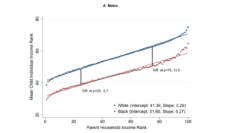In the United States, affirmative action programs have been used to remediate long-standing inequalities that raise the risk of lifetime poverty among underrepresented minorities (URMs). The best-known affirmative programs consider race and ethnicity in college admissions decisions. These programs have faced a great deal of criticism, stemming from concerns about their efficacy and fairness. Consequently, college affirmative action programs (most recently, Harvard University) have faced numerous legal challenges. Since the 1990s, nine states (including California, Texas, and Michigan) have banned the consideration of race in college admission decisions.
College affirmative action bans reduce the likelihood of a URM high school student attending a top college. We wondered whether they led URM high school students to engage in riskier health behaviors, such as smoking and drinking.
This question might seem out of the blue, but it arose as part of our broader work looking at the relationship between economic opportunity and health. While typically not considered in discussions about the social determinants of health, economic opportunity–defined as one’s ability to ascend the socioeconomic ladder regardless of life circumstances–may have dramatic implications for health outcomes. For starters, higher lifetime economic opportunity could raise the incentive for young people to stay healthy, as doing so allows them to better access these opportunities and reap their awards. In addition, economic opportunities may affect beliefs about future well-being, which may directly affect mental and physical health through increasing stress.
In earlier work, we found that counties with higher economic opportunity tended to have better health behaviors and outcomes, even after accounting for other social and economic factors. However, these results don’t tell us whether economic opportunity causes health.
What do these findings mean? At minimum, they show that decisions to implement or terminate college affirmative policies should take into account any potential consequences for health, in addition to their effects on educational outcomes.
This is where affirmative action bans come in. By reducing the likelihood of attending selective colleges, these bans may diminish expectations of economic opportunities among URM high-school students. By doing so, they may reduce the perceived returns of staying healthy and avoiding health risk behaviors. Affirmative action bans may also raise the risk of unhealthy behaviors through other pathways, including increased stress from greater competition for college spots or broad signals about societal discrimination.
Because affirmative action bans were implemented in different states at different times, we were able to compare changes in health behaviors among URM junior and senior high school students in states passing bans to the same changes among URM students living in states without bans. This “natural experiment” design allows us to be more confident–though not certain–about a causal relationship between affirmative action bans and health behaviors.
Using data from a large, nationally-representative survey of youth in the United States, we found that implementing an affirmative action ban led to large increases in current cigarette smoking and alcohol use among URM juniors and seniors. The rise in the risk of smoking and alcohol use was timed exactly with the period the affirmative action ban was actively being considered and implemented. Moreover, using another dataset, we found that URM high school students who were in their junior and senior year at the time their state implemented affirmative action bans were still more likely to smoke as adults. We found no change in any of these health risk behaviors among non-Hispanic white students, for whom we expected college affirmative action bans to be less salient.
What do these findings mean? At minimum, they show that decisions to implement or terminate college affirmative policies should take into account any potential consequences for health, in addition to their effects on educational outcomes. More broadly, we think these data show that social policies–particularly those that shift economic opportunities–may have large and persistent effects on population health.
Photo by Tai’s Captures on Unsplash














